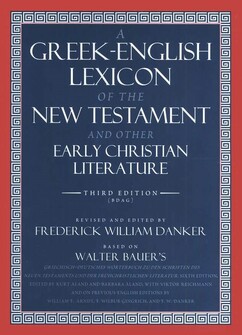Galatians 2:16 reads, “But knowing that a human is not justified from works of the law but through pistis Iesou Christou, we also trusted in Jesus Christ in order that we might be justified from pistis Christou and not from works of the law because from works of the law, no flesh will be justified.” The phrase that I’ve left untranslated—pistis Christou—occurs at pivotal points in Paul’s explanation about justification/righteousness, law, and faith (Rom 3:22, 26; Gal 2:16 [2x]; 3:22; Phil 3:9; Eph 3:12) and has, therefore, been at the center of a heated grammatical and subsequently theological debate.
Most modern versions opt for a translation of the phrase as “faith in Jesus Christ.” This rendering has been called the objective genitive view. Over the past several decades, though, another view has gained traction in the scholarly world, translating the phrase as the “faithfulness of Jesus Christ.” This rendering has been called the subjective genitive view. These two views have dominated the discussion in modern scholarship. At the end of 2020, I published an article on the so-called pistis Christou debate in the Journal for the Study of the New Testament, aiming to bring clarity and consensus to the conversation.1
Using modern linguistic tools, my article set out to show that both the objective and subjective genitive views have serious problems linguistically, and that the objective view was not even a possible option. Hence, the title of my article: “A Linguistic Analysis of Pistis Christou: The Case for the Third View.” My translation of the phrase is “Christ-faith,” referring to the faith that was preached about Jesus the Messiah. The word “Christ” gives the content of the faith. We can call this a content genitive. With this initial framing, we can return to Galatians 2:16 to see how each position would translate the phrase:
Objective Genitive: “But knowing that a human is not justified from works of the law but through faith in Jesus Christ, we also trusted in Jesus Christ in order that we might be justified from faith in Christ…”
Subjective Genitive: “But knowing that a human is not justified from works of the law but through the faithfulness of Jesus Christ, we also trusted in Jesus Christ in order that we might be justified from the faithfulness of Christ…”
Content Genitive: “But knowing that a human is not justified from works of the law but through the Jesus-Christ-faith, we also trusted in Jesus Christ in order that we might be justified from the Christ-faith…”
To my knowledge, there has not yet been direct engagement with my article in published works, though it has received a fair amount of scholarly attention for an article. Matt Bates interviewed me about it on the popular podcast OnScript, and a fair amount of attention was given to it at the last SBL annual meeting session that was devoted to David Downs and Benjamin Lappenga’s book, The Faithfulness of the Risen Christ, which is also on the pistis-Christou debate.
One of the consistent (justifiable) complaints about my article is that the linguistic terms make it difficult to understand, and I have received requests from both scholars and laypeople to “translate” the article into a form that normal English speakers can comprehend—without using technical linguistic terms like argument structure, Referential-nominal, and deverbal noun. I do believe that the linguistic components of the article are important, and those that would seriously engage with it should also engage with those arguments. Solving an old problem often requires a new tool. And yet, arguments that are not properly understood cannot be properly engaged with, and I recognize that even many scholars have found the linguistic terms difficult to wade through. I hope that this extended blog post can both serve as an accessible synthesis of my basic thesis and as a bridge to help scholars engage more meaningfully with my fuller treatment in the article.
1. Grammatical arguments
1.a. Grammatical foundation
My basic grammatical argument can be distilled to something quite simple. Just like the verbal constructions believe in and believe that in English are different grammatical constructions that have different meanings, so also the nominal constructions belief in and belief that are different grammatical constructions with different meanings. This can be demonstrated with the following set of examples:
- John believed Mary that she raised a pet bear.
- John believed in Mary that she could raise a pet bear.
The introduction of the word in changes the meaning of the verb believe. To believe in someone is not the same as to believe someone. When we say we believe someone, we usually mean that we believe a statement that the person made is true. In contrast, when we say we believe in someone, we usually mean that we believe that that person has the ability to do something. (To be sure, the meaning of believe in is more complex than this, but these complexities aren’t important for us here.) Importantly, we can say John believed Mary that she could raise a pet bear, typically understanding this as John believing Mary’s claim that she could. However, it would be odd to say *John believed in Mary that she raised a pet bear (the * is used in linguistics for sentences that are ungrammatical). Put most simply, we might synthesize the discussion in the following way:
- “Believe someone” is about believing someone’s claim is true.
- “Believe in someone” is about believing someone has a certain ability.
We’re left with a key point: Syntax, which words appear in what order, reflects semantics, the meaning of the utterance.
With the syntax of the verb believe as a starting point, we turn to the use of the noun belief. Consider the following examples:
- John’s belief of Mary that she raised a pet bear (was unfounded).
- John’s belief in Mary that she could raise a pet bear (was unfounded).
Notice that John’s belief of/in Mary behaves identically to John believes (in) Mary which we saw in the previous examples. In other words, the noun belief has an identical structure to the verb believe. Just like we saw with the verb, when the syntax changes, the semantics does as well. Nouns that behave this way are called deverbal nouns—they are nouns derived from verbs, reflecting the same syntax and semantics found in the verb. Because the noun belief shares the same syntactic and semantic structure of the underlying verb believe in these readings, such interpretations have been called argument-structure (AS) readings of a noun—the arguments of the verb (those elements required to complete the thought of the verb) and their structure (whether they are organized as prepositional complements, direct objects, etc.) are carried over from the verb to the noun.
Crucially, this is not an exhaustive description of the meaning of belief. Sometimes the word belief can refer to the thing that is believed and not to the state of believing itself. Contrast for example, the following three examples:
- John’s belief of Mary that she raised a pet bear (was unfounded).
- John’s belief in Mary that she could raise a pet bear (was unfounded).
- That Mary can raise a pet bear is an absurd belief.
In the first two examples, which we looked at above, the word belief refers to John’s state of believing. Here, it could either be John’s belief that a statement is true (example 1) or of John’s belief in Mary’s ability (example 2). In the third example, however, the word belief refers to the thing/statement that is believed. We are dealing with the content of the belief itself. This kind of reading of the noun has been called the referential (R) reading because the noun refers to an entity, whether concrete or abstract, and not to an event or state represented by the underlying verb.
This kind of ambiguity for such (deverbal) nouns is pervasive across languages and across noun types. This ambiguity is not unique to belief! The word building can refer to the thing built or the action of constructing something; examination can refer to the act of examining or the result of the act; knowledge can refer to the state of knowledge or the thing known, etc.
1.b. The objective genitive view
This foray into grammar lays the foundation for our approach to pistis Christou. The basic argument is simple: pistis behaves just like belief in English. It is a so-called deverbal noun that reflects the structure and meaning of its verbal counterpart. Those arguing for the objective genitive position normally translate the phrase as “belief in,” but the problem with this is that the noun pistis does not have the meaning “belief in” when it has an objective genitive. The noun pistis with an objective genitive instead means “belief of [something/someone that the/their claim is true].” With a preposition like eis or en, both the noun pistis and the verb pisteuo can mean “belief/believe in someone,” but our phrase does not have a preposition. If Paul wanted to express the meaning “belief in,” he would have used a preposition—but he didn’t.
In terms of the best English term to reflect its meaning, pistis has a range of interpretation that includes but is not limited to “belief.” Indeed, recent scholarship is quite clear that it can mean “belief,” but need not always mean “belief.”2
Instead, pistis can also refer to “having faith/trust in” or “being faithful to” someone or to “faith” itself. The relationship of the verb to the noun is clear, as we can see in the following examples:
- Not only to trust (pisteuo; verb) in him (eis auton) (Phil 1:29).
- The steadfastness of your trust (pistis; noun) in him (eis auton) (Col 2:5).
In the example from Philippians 1:29, the verb is used with a preposition (eis) to mean “trusting in/being faithful to” Jesus, while the noun is used identically in Colossians 2:5 with the same exact preposition (eis) to mean the same exact thing: “trusting in/being faithful to” Jesus.
Crucially, the verb pisteuo (“believe/have faith”) usually has two kinds of words after it. It can either take a person that someone “trusts in/is faithful to” (pisteuo “in”) or a statement or proposition that can be believed (pisteuo “that”). My claim is that the noun pistis also has these readings. Further, just like we can tell what the verb means by the syntax, we can discern what the noun means in the same way. Thus, we see the following trend:
- pistis + preposition (eis/en and person) = pisteuo + preposition (eis/en and person)
- pistis + genitive = pisteuo + content of belief (oti or content noun in dative/accusative)
For the meaning “trust in/be faithful to,” we have a person introduced with a preposition (pistis “in”). For the meaning of “believing something to be true,” we have the genitive (pistis “of”). Since pistis is a deverbal noun, we expect this parallel syntax with the verb and, indeed, it is systematic and pervasive in the data, both within and outside of the New Testament. (See my article for an in-depth analysis of the data.)
Thus, the basic problem with the so-called objective genitive is that the Greek construction pistis Christou cannot mean “faith in” Jesus because this meaning is associated with a different syntactic construction. That is, “faith in” must be accompanied by the construction with the preposition (or a dative that replaces the preposition). The objective genitive never has this meaning. Instead, that construction (pistis “of”) always means “believing something to be true.” This, however, is not what the advocates of the objective genitive view argue that it means; proponents of the objective genitive view want the construction pistis + genitive to mean the same thing as pistis + the preposition en/eis. They want it to mean “trust/faith in” someone, but the syntax disallows this. As I show in my article, every case of a genitive following pistis in the New Testament (and outside of it) can be explained in a better way. It just doesn’t have the right meaning. Just like belief in ≠ belief of, so too pistis en/eis ≠ pistis + genitive. Those on the side of the objective genitive have to make those syntactic constructions equivalent.
1.c. The subjective genitive view
At this point, the subjectivists are beginning to raise their flag in victory. This has been the nature of the debate. It has been assumed that there are only two interpretive options (“faith in Christ” or “faithfulness of Christ”), so both sides have treated an argument against the other side as an argument for their side. As the title of my article suggests, this is an overhasty conclusion—there is a third contender in the fight.
But before turning to the third view, we must note that there are also grammatical reasons for rejecting the subjective genitive interpretation. The first, and perhaps most significant, is the lack of any article. In Greek, the word “the” behaves quite differently than “the” in English, so caution is warranted here. There is no corresponding word to “the” in our phrase pistis Christou, but we would expect it if the subjective genitive position were correct. It bears repeating what Ernest Burton said about subjective genitives in this respect: the article is “almost invariably present.”3 (I treat this issue more fully in my article, as well.) This is something that must be dealt with seriously in the data.
It is also unclear from the context to whom or to what Jesus is exercising his faithfulness. Some have made appeals to the overarching narrative of Galatians or Romans, but this is not helpful here. Grammatically, we need a specific noun in the context that can serve as the person or thing to which Jesus is faithful. More significantly, this noun would need to be so obvious that Paul does not feel the need to express it. In point of fact, Paul frequently omits the object of the verb pisteuo when referring to “believers” because everyone knows that Paul is speaking of those who have “faith/believe in” Jesus Messiah. However, the omission of the object in our construction is not the same—even the subjectivists themselves cannot agree on who or what Jesus is faithful to (God, God’s plan, his death, his own mission, and others have all been proposed). Since what Jesus would be faithful to is not obvious, we should not assume that Paul would use a construction where the object of Jesus’s faithfulness would have to be supplied.
2. The third view
If both sides are wrong, what other options do we have? I suggest that the best translation of the phrase is “Christ-faith,” or the faith that is about Jesus the Christ. I am not the first to advocate for a third view. (Preston Sprinkle has helpfully cataloged all those in the modern era that held such a view.)4
Unlike advocates of either the objective genitive (in which the genitive is the object of a verb) or subjective genitive (in which the genitive is the subject of a verb), I suggest that in this phrase the meaning of pistis is not related to the meaning of the verb pisteuo.
On this view, since the noun is not related to the meaning of the verb, the genitive can be neither subjective nor objective. Instead, the noun refers to something else: the system of belief that can be adopted, believed, preached, or joined. (A standard dictionary like BDAG lists this as an option.) We have already seen that deverbal nouns can have a range of meaning besides those that correspond to their verbal counterparts. Just like belief in English, pistis can refer to what someone has faith in, and this meaning fits the context and grammar better than pistis as referring to the state of having faith.
Besides the grammatical arguments against the subjective and objective genitives and the positive arguments I have put forward in my article, one aspect of the debate that has not received enough attention is how the phrase was read in antiquity by native Greek speakers. Indeed, just as we don’t expect native speakers of English to mistake belief (of) for belief (in), we don’t expect native Greek speakers to do the same. This can be clearly demonstrated from the exegesis of the earliest interpreters.
2.a. Modern scholarship vs. the ancients
George Howard demonstrated that translating the phrase “faith in” Jesus was one of Luther’s innovations.5
On the subjective side, Benjamin Schliesser gives a history of the interpretation of the subjective genitive, showing that it dates back to the early 1800s.6
This begs the question: How did the earliest interpreters, especially those who spoke Greek as a native language, interpret the phrase? Roy Harrisville surveys how the early church fathers understood the pistis Christou phrase, and he finds that none of them took the genitive to be subjective.7
Of course, this is not definitive proof against the subjective position, but it is strong evidence, particularly considering that this phrase was not a debated point in antiquity as far as we are aware. Disputed interpretations often lead to biases, but there were no theological or polemical reasons for early native Greek speakers to take the genitive in any way (unlike in scholarship today). In Harrisville’s survey, he demonstrates convincingly that none of the earliest uses or explanations of the phrase pistis Christou can be interpreted as a subjective genitive, and he concludes from this that they must be objective. However, a closer look at the context shows that early native Greek speakers like Origen and Chrysostom interpreted the phrase as the “Christ-faith,” as I demonstrate in my article. While the objective genitive view can be ruled out completely on the basis of linguistic analysis, the subjective genitive view is rendered highly improbable by both the grammar and reception history.
As an early example, which Harrisville brings up, to demonstrate the third-view reading of the pistis Christou phrase, we can look at the Greek Acts of Peter, which is a document dating to the end of the second century describing the martyrdom of Peter. Harrisville brings up the phrase as it is used in a dialogue between Peter and Simon the Magician, but the earliest Greek manuscript we have also begins with the phrase in the first sentence. It reads, “On the Lord’s day, as Peter was conversing with the brothers and encouraging them in the Christ-faith (pistis Christou) …” Both the context and the syntax suggest that this phrase is best understood as the third view. It refers to the faith which someone can be a member of and which someone can be encouraged to continue to hold fast to.
Later in the Acts of Peter, Simon the Magician says, “If your God [i.e., Christ] is able, whom the Jews killed … show that his faith [pistis autou] is of God.” This is the passage mentioned by Harrisville. In context, Simon the Magician is questioning the veracity of Peter’s faith as a whole. The question is whether the faith that Peter has adopted is really of God or not, and Simon the Magician essentially asks Peter to prove it. The magician then proceeds to start levitating before Peter prays for him to fall and break his leg in three places, and the magician’s subsequent crash demonstrates to everyone watching that the faith that Peter has adopted, the Christ-faith, really is of God. It has power over the magician. The word pistis in this context is not referring to Jesus’s faithfulness, nor is it referring to faith in the Christ—it is referring to the kind of faith that Peter has adopted and which gives him power over even supernatural forces. This reading of pistis Christou is ubiquitous among the early church fathers and early native Greek speakers—they always use it to refer to the Christ-faith.
2.b. Romans 3:20–22
Each of the passages in the New Testament with the pistis Christou phrase has a similar polemical flavor as the Acts of Peter. However, instead of a pagan questioning whether the Christ-faith is of God or not, it is Jews that have argued that it is Torah-works and not the Christ-faith that leads to righteousness/justification. We can look at Romans 3:20–22 as a test case.
Therefore, from Torah-works no flesh will be justified before him, for through Torah is the knowledge of sin. Now the righteousness of God has been manifested apart from Torah, being witnessed to by the Torah and the Prophets, the righteousness of God through the Jesus-Christ-faith for all who are faithful.
Each word in this passage has garnered a tremendous amount of attention, and we cannot begin to do justice to each word here. That being said, one passage from the end of Mishnah Makkot is instructive for the kind of position Paul may have been arguing against. Rabbi Hananya ben Gamliel, a Rabbi of the first and second centuries, says, “And if for one who performs one transgression his soul is taken for it, as one’s soul can be uprooted from the world for one transgression, for one who performs a single mitzva [commandment], it is all the more so the case that his soul will be given to him, as the reward for performing mitzvot [commandments] is greater than the punishment for performing transgressions.”
The connection of this passage to many issues surrounding the New Perspective should be obvious. Devora Steinmetz discusses this text at length in her article on “Justification by Deed,” including how it relates to E. P. Sanders’s work.8
Our only point here is that this kind of perspective reflects a Torah-centric Judaism where it is obedience specifically to commands of Torah that leads to righteousness and ultimately salvation. In contrast, Paul claims that righteousness comes from the Christ-faith. It is not the system of Torah-works that brings about righteousness: it is the adoption of the Christ-faith that leads to true righteousness. What must one do to adopt the Christ-faith? Be faithful to the Christ, the Messiah of Israel.
When our terms are set up in this way, the contrast between “the Christ-faith” and “works of Torah” leads us to a better understanding of the passage. The main contrast is between the Christ and the Torah, not necessarily faith and works. Faith and works are contrasted insofar as one is associated with the Christ and the other with Torah, but that misses the main point. If righteousness comes through the commandments of Torah, then gentiles must obey those commandments to become righteous, but if righteousness comes through the Christ-faith, then all they must do is be faithful to the Christ. In adopting the Christ-faith and being faithful to the Christ, they will fulfill the Torah, as it was intended (through love; e.g., Rom 13:8–10), but they will not need to adopt the system of Torah-works, which would include all of its commandments, including (but not limited to) the so-called “boundary marker” commandments such as circumcision and food laws. For Paul, adopting the Christ faith is not a rejection of the Torah; it is a different interpretation of it. He claims, of course, that it is the correct one (Rom 3:31), and he demonstrates this by using Abraham as an example. Before the system of Torah-works came at Sinai, the Torah itself says that it is faith/faithfulness that is credited as righteousness for Abraham (Rom 4:5). The correct interpretation of Torah supports what the Christ-faith is advocating for and not what the system of Torah-works proposes as the path to righteousness, which is obedience to Torah’s commandments. This is what Paul is arguing against: an alternative system based on the commandments of Torah that, so it was claimed, would lead to righteousness. Paul claims that Torah itself points to the Christ-faith, and the response of “faith/faithfulness” exemplified by Abraham, as the only path to righteousness for Jew or gentile.
3. Recent scholarship
Since publishing my article, the pistis Christou debate has continued to receive its fair share of treatment in the scholarly world. One significant work published a year before mine (but after mine was already written and under review) is The Faithfulness of the Risen Christ by David Downs and Benjamin Lappenga, which, as mentioned above, was discussed in an SBL session this past year. The basic thesis of the book is that the subjective genitive is correct, but it should be understood more broadly than just Jesus’s faithfulness to his death. They suggest that the phrase “refers primarily to the faithfulness of the risen Christ Jesus who will remain faithful to those who, in their own faith, are justified through union with Christ, raised and exalted.”9
They emphasize Christ as the one who is risen and faithful over against Christ being faithful primarily to his death on the cross—the more usual description of what Christ is faithful to according to advocates of the subjective genitive. To show this, they highlight passages that are not usually considered in the debate (such as 2 Tim 2:8–13), and they employ a more robust linguistic framework than is usually done in attempting to solve the problem. In particular, they adopt relevance theory (which Wikipedia has a good introduction to) as a way to try to disambiguate the meaning of “faith” in context. Both looking at neglected passages and using linguistics to help solve the problem are much-needed correctives to dislodge the impasse.
Space does not permit a full review of Downs and Lappenga’s work. If my memory serves me right of the conversation I had with them at the past SBL Annual Meeting about the relationship between my work and theirs, I do not think we are that far off. They want to broaden the pistis Christou phrase to refer to something like the entire story of Christ. That is what is being referred to in his “faithfulness,” and I agree that a broader understanding of the story of Christ better fits the context. However, strictly speaking, “faithfulness” would be an attribute of Christ in their view and would not refer to the story itself. According to the syntax (which they do not discuss to any great extent), I do not think this makes the best sense of how to interpret the word pistis, for all the reasons given above and in my article. My view is that the Greek term pistis in this context actually refers to something that can be preached or adopted, something with content that could very well be a story. The noun Christou then gives us the content of what someone has faith in. This “faith” is more than, but not less than, the story of how the Messiah of Israel was obedient during his life and faithful to his death on the cross and raised and exalted as king. As Paul says in Galatians 1:23, this is the faith he preached. It is the Christ-faith.
Another work which was in the publishing process at the same time as mine but was released after is Nijay Gupta’s survey chapter on the debate as part of the new Oxford Handbook of Pauline Studies.10
Gupta helpfully touches on many of the issues that need to be discussed in order to provide a satisfactory analysis, including how the phrase was used and understood in other early Greek writings (which we briefly mentioned above and which I treat more fully in my article). The chapter itself is devoted primarily to the subjective and objective genitive interpretations, though a few paragraphs are devoted to “third-view” readings. For those interested in the modern history of the debate and its key players, there is also a section devoted to a history of modern scholarship. This survey, along with the other surveys in the past decade or so,11 are helpful places to start for those interested in the debate. Gupta, however, is much more pessimistic about grammar’s role in the whole debate, concluding with “Debates on the basis of syntax are all but gone, and good riddance!”12 Of course, I beg to differ. The issue is syntactic, and syntax is the key to solving the problem. Outside of my own treatment of the problem, I do not believe anyone has actually employed syntactic arguments based on modern linguistic theory. It is more, not less, syntax that we need.
Even more recently, Teresa Morgan has doubled down on her double reading of the pistis Christou phrase in her important new monograph, The New Testament and the Theology of Trust. In my article, I did not deal extensively with those who advocate for a double meaning of the phrase, only quipping that “that’s not how language normally works.” While this is true, a more evidence-based critique can be made. Advocates of the double-reading must, of course, deal with my linguistic arguments against both the objective and subjective interpretations, but in order to provide a satisfactory account of the phrase, we would need a clear demonstration of phrases similar to the debated pistis Christou having that double reading. This has yet to be demonstrated.
4. New directions and Habakkuk 2:4
Let me conclude by discussing one more potential implication of my understanding of the pistis Christou phrase. Once we admit that the noun pistis may mean a system that can be adopted, this then becomes a possible meaning in other places as well, and reading Paul’s quote of Habakkuk 2:4 in this way makes a lot of sense, both of the context and the reason why Paul seems to “misquote” the actual verse. A version like the ESV translates Paul’s quote as “The righteous shall live by faith,” which is normally understood to mean that the righteous person will live according to the principle of (their own) faith in Jesus. However, such an English translation disallows another reading of the Greek that is actually much more natural: “The righteous one from the faith will live.” In other words, it would mean that the person who is righteous by virtue of being a part of the faith (i.e., the Christ-faith) will be the one who lives. Given that it is through the Christ-faith that the righteousness of God is revealed (Rom 3:21–22), this makes perfect sense. Adopting the Christ-faith leads to righteousness. Thus, the righteousness of God is not only revealed from (ek) the (Christ-)faith, but it is also for the sake of (eis) the (Christ-)faith (Rom 1:17), since it is those of the faith who will benefit from it, i.e., they will have life. Hence, the righteousness of God is revealed both from the faith and for the faith.
As we said above, Paul seems to “misquote” Habakkuk, and it is precisely at the point of deciding whose “faith” (pistis) is in question. While the Hebrew says the righteous person “by his faith” will live, the Septuagint says that the righteous person “by my faith” will live. In other words, the Hebrew is referring to the righteous person’s faith, and the Greek is referring to God’s “faith.” The two letters in the Hebrew which would represent either “his” or “my” look very similar, so the confusion is understandable. What is far less likely from a textual perspective is that Paul was reading a version that totally omitted the pronoun. In other words, he probably wasn’t reading a version that looks like his quote. Instead, I suggest, Paul took out the pronoun to make a point—the faith being referred to is not anyone’s faith in particular. It is the faith concerning the Messiah, the Christ-faith, that reveals God’s righteousness, and the person who has become righteous by adopting this faith will live. This is the faith that Paul preached (Gal 1:23), the one that tells the story of Jesus as Israel’s Messiah who was indeed faithful to God’s plan of salvation. It is adopting the Christ-faith that leads to obedience, and this faith calls people everywhere to respond in faithfulness to Jesus as the messianic king.
***
Further resources

A Greek–English Lexicon of the New Testament and Other Early Christian Literature, 3rd ed. (BDAG)
Regular price: $149.99
A Critical and Exegetical Commentary on the Epistle to the Galatians (ICC)
Regular price: $43.99
The Faith of Jesus Christ: Exegetical, Theological, and Biblical Studies
Regular price: $25.99
- Kevin Grasso, “A Linguistic Analysis of πίστις χριστοῦ: The Case for the Third View,” Journal for the Study of the New Testament 43.1 (2020): 108–44.
- Teresa Morgan, Roman Faith and Christian Faith: Pistis and Fides in the Early Roman Empire and Early Churches (Oxford: Oxford University Press, 2015); ibid., The New Testament and the Theology of Trust: “This Rich Trust” (Oxford: Oxford University Press, 2022).
- Ernest DeWitt Burton, A Critical and Exegetical Commentary on the Epistle to the Galatians, vol. 36 (New York: Charles Scribner’s Sons, 1920), 482.
- Preston M. Sprinkle, “Πίστις Χρίστου as an Eschatological Event,” in The Faith of Jesus Christ, edited by Preston M. Sprinkle and Michael Bird (Ada, MI: Baker Academic, 2009), 165–84.
- George Howard, “Faith (faith of Christ),” in Anchor Yale Bible Dictionary, edited by D. N. Freedman (New Haven, CT: Yale University Press, 1992): 758–60.
- Benjamin Schliesser, “‘Exegetical Amnesia’ and Πίστις Χριστοῦ: The Faith of Christ in 19th-Century Pauline Scholarship,” Journal of Theological Studies 66.1 (2015): 61–89.
- Roy Harrisville III, “ΠΙΣΤΙΣ ΧΡΙΣΤΟΥ: Witness of the Fathers,” Novum Testamentum (1994): 233–41.
- Devora Steinmetz, “Justification by Deed: The Conclusion of Sanhedrin-Makkot and Paul’s Rejection of Law,” Hebrew Union College Annual (2005): 133–87.
- David J. Downs and Benjamin J. Lappenga, The Faithfulness of the Risen Christ: Pistis and the Exalted Lord in the Pauline Letters (Waco, TX: Baylor University Press, 2019), 3.
- Nijay Gupta, “Paul and Pistis Christou,” in The Oxford Handbook of Pauline Studies, edited by Matthew V. and R. Barry Matlock (Oxford: Oxford University Press, 2022).
- Matthew C. Easter, “The Pistis Christou Debate: Main Arguments and Responses in Summary,” Currents in Biblical Research 9.1 (2010): 33–47; Chris Kugler, “ΠΙΣΤΙΣ ΧΡΙΣΤΟΥ: The Current State of Play and the Key Arguments,” Currents in Biblical Research 14.2 (2016): 244–55; cf. also my own survey in my article.
- Gupta, “Paul and Pistis Christou,” 484.







